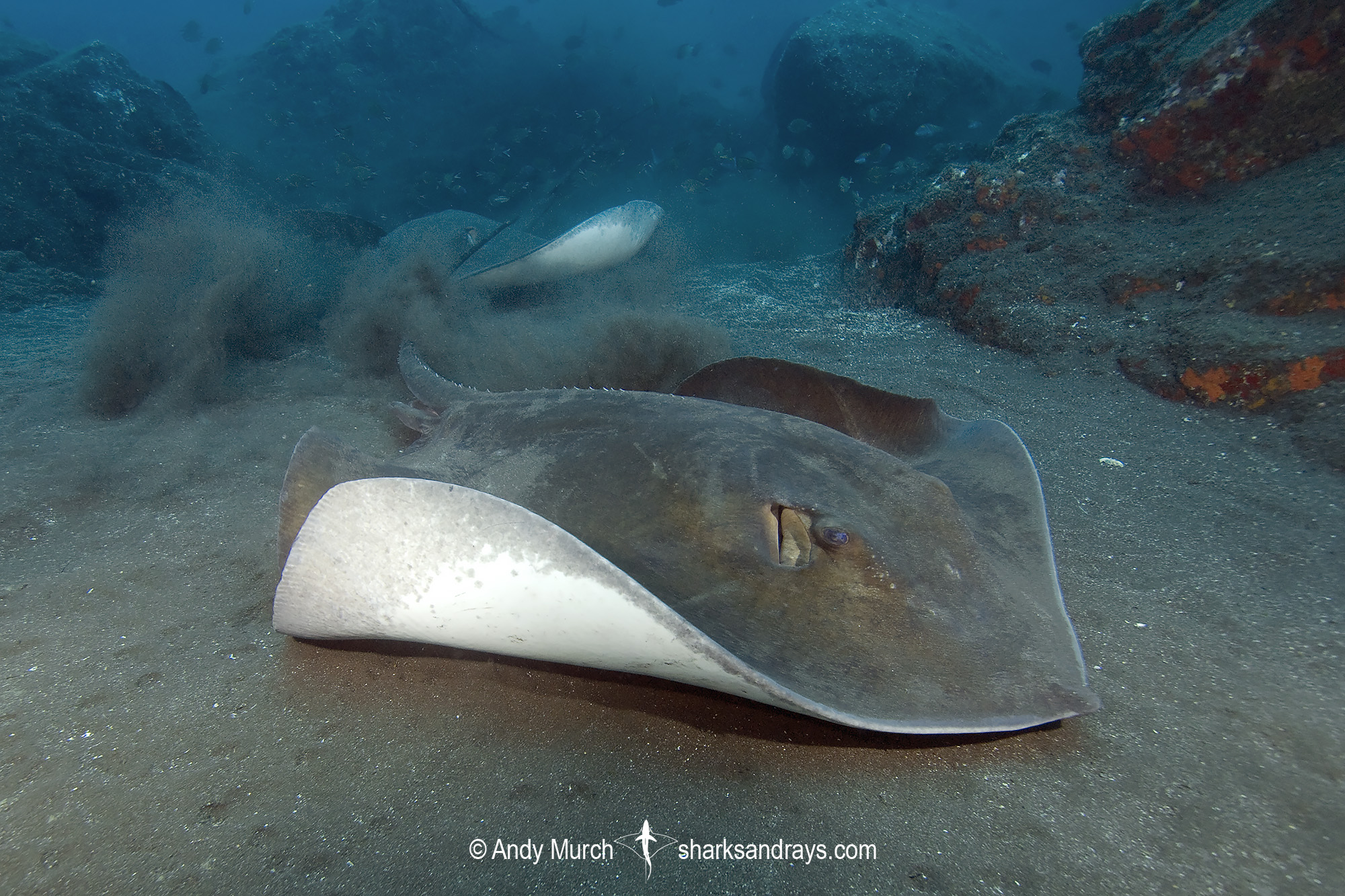Common names
Brown Stingray, Black Stingray.
Binomial
Bathytoshia lata.
Synonyms
Dasyatis lata, Dasyatis latus, Dasyatis lubricus, Dasyatis sciera, Dasyatis thetidis, Dasyatis ushiei, Dasyatis ushieri, Dasybatis agulhensis, Dasybatis ushiei, Dasybatus agulhensis, Trygon lata.
Identification
A very large, thick bodied stingray with a kite-shaped disc that is slightly wider than long; disc width approximately 1.2-1.3 x length. Snout short and obtuse with a small, triangular, protruding tip. Anterior margins of disc mildly undulate. Pectoral fin apexes narrowly rounded or angular. Pelvic fins relatively small with narrowly rounded or angular apexes.
Eyes relatively small. Snout length 2.1-2.5 x combined eye and spiracle length.
Mouth contains 3-5 oral papillae. Weak labial furrows around mouth. Lower jaw weakly convex. Extremely broad, skirt shaped nasal curtain with a fringed margin. Nostrils oval shaped. Dorsal surface of juveniles lacks dermal denticles except for a row of stellate thorns and tubercles on midline. Adults have more pronounced thorns on midline, and generally more granulate skin including small thorns on snout. Sharp thornlets cover tail beyond caudal spine. Tail wide and depressed at base; tapering gently to tail spine. Tail beyond spines thin and covered in small thorns. Tail length (when intact) 2x disc width. Dorsal finfold indistinct. Ventral finfold long and low; basal length equal to distance between snout and cloaca.
Colour
Dorsum uniformly grey-brown or almost black. No visible rows of white pores pectoral fins. Ventrum white; usually with a dusky disc margin. Tail fades to black beyond tail spine.
Size
Maximum disc width possibly 260cm. Disc width at birth approximately 35cm.

Conservation Status
VULNERABLE
The brown stingray is commonly caught in trawl, line, gillnet fisheries. Throughout most of its range it is retained for its meat. It is afforded some protection by its depth (0-800m). Populations in Australia and New Zealand remain fairly stable, but elsewhere bathytoshia lata has undergone an estimated population reduction of 30–49% over the past three generation lengths (65 years).

Habitat
Temperate and tropical seas. On soft substrates, sometimes adjacent to reefs. From shallow bays to 800m on the continental slope.
Distribution
Wide ranging but absent from the Americas. The brown stingray is found throughout the Mediterranean southward to southwest Africa. It has a patchy distribution in the Indian Ocean and southeast Asia, but is quite common in southern Australia. Also in the west and central Pacific to Hawaii.
Reproduction
Matrotrophic aplacental viviparity. Litter size unknown.
Diet
Diet consists of crabs, prawns, and small fishes.
Behavior
Spends much of the day resting on the substrate.
Reaction to divers
Shy but approachable with non-aggressive movements. Generally bolts if approached closely.
Diving logistics
Brown stingrays are regularly encountered at numerous sites in the Mediterranean and around southern Australia. In Australia, they are often referred to as black stingrays or sometimes bull rays.
CANARY ISLANDS
Los Gigantes on Tenerife is the place to encounter this species close to Europe. Los Gigantes Dive Centre runs feeds twice weekly that attract up to six species of rays usually including this one.
AUSTRALIA & NEW ZEALAND
Sightings in Australia and NZ occur mostly during November and February. This species appears to be more migratory than the sympatric short-tail stingray.
Good spots appear to along the coast of New South Wales, and at dive sights in the far north of New Zealand. However, this could be simply because these areas are well populated and dived more regularly.
SENEGAL
Brown stingrays are commonly encountered at dive sites around Dakar.





